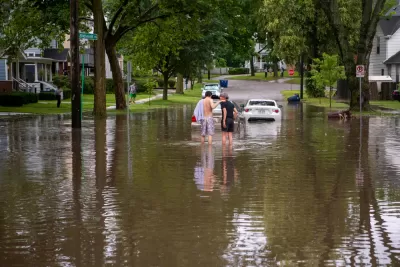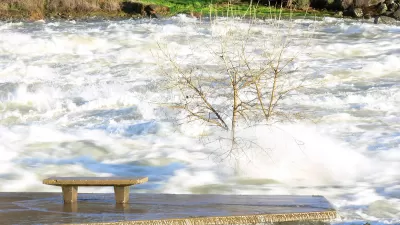The realities of climate change have been on full display in Michigan this summer, and a crusading drain commissioner is pushing for stormwater infrastructure that uses natural features to capture and reuse water during extreme weather.

With memories of massive flooding still fresh from storms this summer, Sarah Grimmer details efforts around the state to increase its stormwater mitigation.
Some in the state are noticing the challenge of stormwater for the first time because the climate in the state is changing. "Since 1986, total annual precipitation across most of Michigan's lower peninsula has increased by more than 10 percent," writes Grimmer.
Now the state and its local and regional planning authorities are facing the challenge of updating its infrastructure—built on old assumptions on how much rain would fall on the state—for the new reality of climate change.
Ingham County Drain Commissioner Patrick Lindemann is cited extensively in the article to describe both the need for new infrastructure, as well as the challenges, like a lack of funding, standing in the way of a more resilient state. Lindemann suggests that instead of simply installing larger drainpipes—a task which many Michigan governments can't afford—a preferable strategy might be to rethink how to handle stormwater altogether.
Instead of funneling excess water in the Great Lakes, Lindemann wants to restore watersheds and create wetlands and ponds. "These projects work to hold rainfall and use it rather than pushing it out," explains Grimmer.
"The drain commissioner's goal is to build around 50 of these projects in Ingham County, he says it will take about 40 to 50 years to get this work done and, in the process, rebuild the county's infrastructure so that it can handle our new environment."
FULL STORY: Massive rainfall events aren't going away in Michigan. Experts say our infrastructure needs to adapt

Trump Administration Could Effectively End Housing Voucher Program
Federal officials are eyeing major cuts to the Section 8 program that helps millions of low-income households pay rent.

Planetizen Federal Action Tracker
A weekly monitor of how Trump’s orders and actions are impacting planners and planning in America.

The 120 Year Old Tiny Home Villages That Sheltered San Francisco’s Earthquake Refugees
More than a century ago, San Francisco mobilized to house thousands of residents displaced by the 1906 earthquake. Could their strategy offer a model for the present?

HSR Reaches Key Settlement in Northern California City
The state’s high-speed rail authority reached an agreement with Millbrae, a key city on the train’s proposed route to San Francisco.

Washington State Legislature Passes Parking Reform Bill
A bill that would limit parking requirements for new developments is headed to the governor’s desk.

Missouri Law Would Ban Protections for Housing Voucher Users
A state law seeks to overturn source-of-income discrimination bans passed by several Missouri cities.
Urban Design for Planners 1: Software Tools
This six-course series explores essential urban design concepts using open source software and equips planners with the tools they need to participate fully in the urban design process.
Planning for Universal Design
Learn the tools for implementing Universal Design in planning regulations.
Ada County Highway District
Clanton & Associates, Inc.
Jessamine County Fiscal Court
Institute for Housing and Urban Development Studies (IHS)
City of Grandview
Harvard GSD Executive Education
Toledo-Lucas County Plan Commissions
Salt Lake City
NYU Wagner Graduate School of Public Service





























